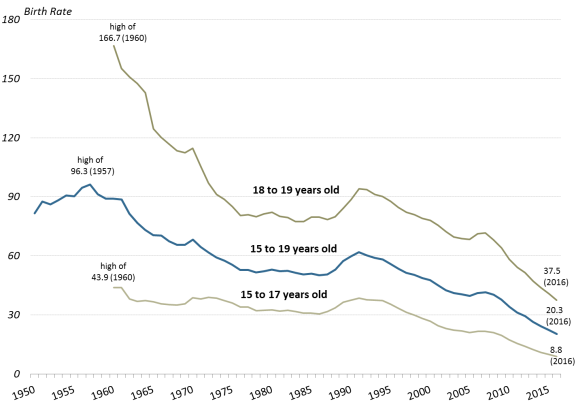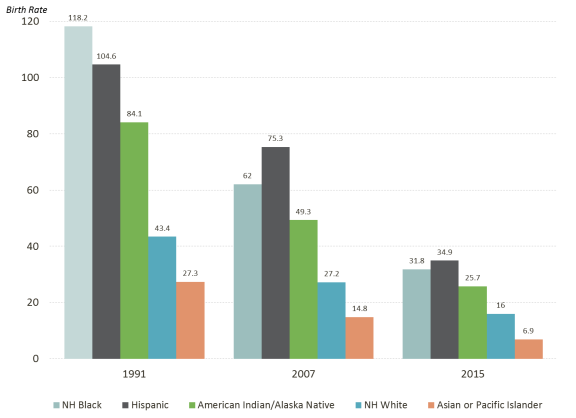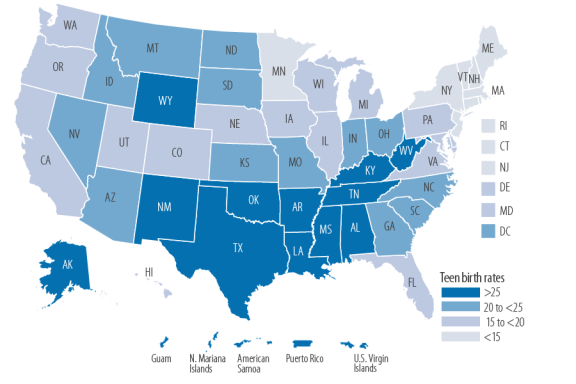Introduction
This report provides context for Congress about the U.S. teen birth rate—or the number of births per 1,000 females aged 15 to 19 each year—and its changes since the 1950s. Over this period, the teen birth rate has generally been in decline. This decline has been most significant in recent years, with the rate reaching a record low in 2016. Multiple factors have likely contributed to the decrease, though the influence of any single factor is not fully known. Reduced teen sexual activity, particularly among younger adolescents, could be one explanation. Increases in use of contraceptives, including highly effective and multiple methods, among sexually active teens could be another. Other factors, such as broader social and economic trends, may also be at play.
Despite the decline in the teen birth rate, Congress continues to be interested in the issue of teen birth because of its high social and economic costs for both individual families and society more generally.1 The Centers for Disease Control and Prevention (CDC), the nation's lead public health agency, has identified teen pregnancy as a major public health issue.2 Further, disparities persist in teen birth rates among racial and ethnic subgroups and across states.
This report accompanies CRS Report R45183, Teen Pregnancy: Federal Prevention Programs, which discusses Congress's current approach of supporting programs that seek to prevent pregnancy among teens in the first place.
Teen Births in the United States
The CDC tracks birth rates nationally, including by age and other characteristics of birth mothers. In 2016, there were nearly 4 million births in the United States.3 About 210,000 of these births (5.3%) were to teenagers aged 15 to 19.4 Figure 1 shows the birth rate for teens aged 15 to 19 from 1950 through 2016 (the rate excludes the territories). The rate ticked up in the "baby boom" era of the 1950s, peaking in 1957 at 96.3 per 1,000 females aged 15 to 19. It then decreased in most years from the 1960s through the 1980s.5 From 1991 onward, the teen birth rate declined except in two years, 2006 and 2007. The rate dropped by 67% from 1991 (61.8 births per females aged 15 to 19) to 2016 (20.3 births to females aged 15 to 19). In other words, about 6% of teens aged 15 to 19 gave birth in 1991 compared to about 2% in 2016. The greatest decline in pregnancy for teens ages 15 to 19 occurred in recent years. For example, from 2007 to 2016, the rate of teen pregnancy declined by slightly more than 50%. The 2016 teen birth rate of 20.3 births per 1,000 females ages 15 to 19 reached a historical low since CDC began collecting and reporting birth data in the 1940s.
The CDC began tracking subgroup data for teens in 1960, when the teen pregnancy rate was highest for both teens aged 15 to 17 (43.9 per 1,000) and teens aged 18 to 19 (166.7 per 1,000). Figure 1 indicates that the birth rate was higher in each year for the older teens compared to the younger teens. The 2016 birth rates for 15- to 17-year-olds (8.8 per 1,000) and 18- to 19-year-olds (37.5 per 1,000) were the lowest on record.
Repeat teen births have also declined over time. A CDC analysis found that the number of subsequent teen births declined nationally by nearly 54% from 2004 to 2015. Over this same period, the largest declines in the repeat birth rate for teens aged 15 to 19 were among black teens (21.8%), followed by Hispanic (16.8%) and white (13.9%) teens.6
With the decline in births to teen mothers, this population has made up a smaller share of births to unmarried women. In 2015 (the most recent year data are available), teens made up about 13% of births to unmarried women. This is compared to 20% in 2010 and 50% in 1970.7
Despite the overall decline in the teen birth rate, the rates for certain racial and ethnic groups remain relatively high. Birth rates for teens aged 15 to 19 in 2015 varied based on race and ethnicity, with three groups—Hispanic (34.9 per 1,000 Hispanic births to females aged 15 to 19), non-Hispanic black (31.8), and non-Hispanic American Indian/Alaska Native teens (25.7)—having more than double the teen birth rate for non-Hispanic white (16.0) and non-Hispanic Asian/Pacific Islander (6.9) teens.8
Figure 2 shows the birth rate for teens aged 15 to 19 by race and Hispanic origin over three key years: 1991, when the teen birth rate started a long-term decline; 2007, the most recent year when the teen birth rate had ticked back up slightly; and 2015, the most recent year for which CDC compiled historical teen birth rate data by race and ethnicity. In nearly each year from 1991 through the recent period, the teen birth rate decreased for all racial and ethnic groups; however, the rates declined more for certain groups compared to others.9 From 2007 to 2015, birth rates fell by 41% for non-Hispanic white teens, 48% for non-Hispanic American Indian/Alaska Native teens, 49% for non-Hispanic black teens, 53% for non-Hispanic Asian/Pacific Islander teens, and 54% for Hispanic teens. While the birth rates for three groups (American Indian, Alaska Native, and black teens) had a greater decline than the rate for white teens, their birth rates remained higher.
In 2016, the birth rate for teens aged 15 to 19 varied considerably by state and territory. The state with the lowest reported rate was Massachusetts (8.5 per 1,000 teens aged 15 to 19 in the state) and the state with the highest reported rate was Arkansas (34.6). Figure 3 shows a map with 2016 teen births rates by quartile for the 50 states, Washington, DC, and five of the territories. The states with rates of less than 15 included Minnesota and eight northeastern states (Connecticut, Massachusetts, Maine, New Hampshire, New Jersey, New York, Rhode Island, and Vermont). The states with the highest teen birth rates (25 or higher) were 10 states concentrated in the South and Southwest (Alabama, Arkansas, Kentucky, Louisiana, Mississippi, New Mexico, Oklahoma, Tennessee, Texas, and West Virginia), and Wyoming and Alaska. The rates for the territories ranged from 29.6 in Puerto Rico to 40.8 in American Samoa.10 From 2007 (when the birth rate last ticked up) to 2016, the birth rate of teens decreased in each state or territory by between 22% and 60%.11 Teen birth rates have also declined in rural areas over time but remain relatively higher than rates in urban areas.12
While the U.S. teen birth rate has decreased over time, it has been higher than that of most other industrialized countries.13 For comparison, the U.S. teen birth rate of 24.2 in 2015 was about 1.5 times that of the United Kingdom, 14.4 in 2015 (based on the most recent international data available).14 The reasons for the high teen birth rate in the United States relative to other industrial countries have not been fully explored. Economic conditions and income inequality within and between countries may play a role.15 Further, the research literature, which is somewhat dated and limited, indicates that use of contraceptives among teens appears to be greater in other developed countries compared to the United States.16
Factors Likely Contributing to Trends in Teen Birth Rates
Researchers suggest that multiple trends have driven down U.S. teen birth rates. They point to certain factors as the reason for the decline in the birth rate over the 1990s through 2007. The research literature indicates that over this period the risk of teen pregnancy decreased because of the declining share of teens, particularly younger teens, ever having sexual intercourse.17 In addition, risk of pregnancy decreased because teens with sexual experience reported improved use of contraceptives. Teens were more likely to use condoms and long-acting hormonal methods and less likely to use withdrawal or no method of contraceptives.18 This change in behavior may have been driven by the national AIDS epidemic.19
Researchers are uncertain about the reasons for the decline in teen pregnancy in more recent years.20 The share of teens who engage in sex has decreased. A nationally representative survey of high school students found that the share of students in grades 9-12 ever having had sexual intercourse dropped from about 48% in 2007 to 41% in 2015.21 Another potential influence in decreasing rates of pregnancy is the increasing use of contraceptives among sexually active teens since 2007. Contraceptive use generally did not increase at the same pace as it did in the earlier period; however, teens have been more likely to use highly effective (i.e., birth control pill; patch; and long-acting reversible contraceptives (LARCs), including intrauterine devices (IUDs), injections, and contraceptive implants) and multiple methods of contraception.22 The abortion rate, which has declined over time, does not appear to be a major factor in contributing to decreasing teen birth rates.23
Broad economic and social variables may influence teen behaviors, such as whether they will abstain from sex or use contraceptives if they have sex. For example, some observers theorize that the long-term downward trend in teen birth rates is attributable to the recession that began in late 2007. They contend that during economic downturns the decrease in teen births—like the decrease in overall births—is partly due to teenagers being more careful as they witness the economic difficulties faced by their families.24 Despite this rationale, the teen birth rate continued to diminish after the recession (as well as during periods of economic expansion in the 1990s). Another possible explanation for the decline is the role of social media and increased use of the internet in teens' knowledge about sex and birth control. One analysis found that there were more rapid declines in rates of teen childbearing in places where the MTV show 16 and Pregnant was more widely viewed.25 The study extrapolated that teens changed their behavior (e.g., increasing the use of contraceptives) after viewing the show. Still, teen birth rates declined even after ratings for the show peaked.
Teen pregnancy prevention programs, such as those supported with federal funding, could potentially play a role in the declining birth rate for teenagers.26 However, the extent to which these programs have caused a decline in the teen birth rate is not fully known. Fewer than half of all states require schools to teach sexual education, and it does not appear that rates of teen pregnancy have dropped more quickly or slowly in states that take a specific approach to sexual education.27 A growing body of evidence shows that selected education models can influence adolescents' decisions about having sex and using contraceptives. Some federal programs require or encourage grant recipients to use models that have met standards for effectiveness.28 Nonetheless, organizations that provide evidence-based or promising teen pregnancy prevention education reach a small share of youth. For example, the grantees funded under the four federal teen pregnancy programs served about 620,000 youth in a one-year period, which accounts for approximately 3% of the population aged 15 to 19.29
Financial and Social Costs of Teen Births
Teen pregnancy has high costs for the families of teen parents and society more generally.30 Teenage mothers and fathers tend to have less education and are more likely to live in poverty than their peers who are not teen parents. For example,
- nearly one-third of teen girls who have dropped out of high school cite pregnancy or parenthood as a reason,
- about 7 out of 10 teen mothers who have moved out of their family's household live below the poverty level, and
- more than 60% of teen mothers receive some type of public benefits within the first year after their children are born.31
Moreover, lower levels of education reduce teen parents' potential for economic self-sufficiency. At the same time, being impoverished and having less education can also increase the likelihood of teens becoming pregnant in the first place.32 These poorer outcomes may be explained in part by underlying differences between those who give birth as teens and those who delay childbearing: teen mothers often come from more disadvantaged backgrounds (e.g., family more likely to receive public welfare benefits, parents have lower levels of education) than their counterparts who have children at a later age.33 In addition, teen sexual activity even among those who do not become pregnant can increase the risk of sexually transmitted infections (STIs), which can led to long-term health issues. Adolescents aged 15 to 19 have certain STIs at a rate that is among the highest of sexually active individuals.34
Further, teen childbearing can also affect the offspring of teen parents. Children of teenage mothers have poorer outcomes than children of mothers who give birth in their early 20s or later. They are generally more likely to (1) have chronic medical conditions, (2) use public health care, (3) have lower school readiness scores, (4) do poorly in school, (4) give birth during their teen years (females), and (5) be incarcerated (males).35 In addition to the consequences for teens and their families, teen childbearing has societal impacts. An analysis by the Power to Decide (formerly the National Campaign to Prevent Teen and Unplanned Pregnancy), a nonpartisan organization that provides information and research on teen pregnancy, found that teen pregnancy cost U.S. taxpayers about $9.4 billion in 2010. The $9.4 billion includes $3.1 billion in child welfare benefits, $2.1 billion in public sector health care expenses, $2.0 billion in spending on incarceration (for sons of teenage mothers), and $2.2 billion in lost tax revenue because of lower earnings of children of teen mothers over their own adult lifetimes.36
Appendix. Additional Data on Teen Pregnancy
Table A-1. Birth Rates for Teens Aged 15 to19, 1950-2016
Birth rate is per 1,000 females aged 15 to 19
|
Year |
Birth Rate |
Year |
Birth Rate |
Year |
Birth Rate |
Year |
Birth Rate |
|
1950 |
81.6 |
1967 |
67.5 |
1984 |
50.6 |
2001 |
45.0 |
|
1951 |
87.6 |
1968 |
65.6 |
1985 |
51.0 |
2002 |
42.6 |
|
1952 |
86.1 |
1969 |
65.5 |
1986 |
50.2 |
2003 |
41.1 |
|
1953 |
88.2 |
1970 |
68.3 |
1987 |
50.6 |
2004 |
40.5 |
|
1954 |
90.6 |
1971 |
64.5 |
1988 |
53.0 |
2005 |
39.7 |
|
1955 |
90.3 |
1972 |
61.7 |
1989 |
57.3 |
2006 |
41.1 |
|
1956 |
94.6 |
1973 |
59.3 |
1990 |
59.9 |
2007 |
41.5 |
|
1957 |
96.3 |
1974 |
57.5 |
1991 |
61.8 |
2008 |
40.2 |
|
1958 |
91.4 |
1975 |
55.6 |
1992 |
60.3 |
2009 |
37.9 |
|
1959 |
89.1 |
1976 |
52.8 |
1993 |
59.0 |
2010 |
34.2 |
|
1960 |
89.1 |
1977 |
52.8 |
1994 |
58.2 |
2011 |
31.3 |
|
1961 |
88.6 |
1978 |
51.5 |
1995 |
56.0 |
2012 |
29.4 |
|
1962 |
81.4 |
1979 |
52.3 |
1996 |
53.5 |
2013 |
26.5 |
|
1963 |
76.7 |
1980 |
53.0 |
1997 |
51.3 |
2014 |
24.2 |
|
1964 |
73.1 |
1981 |
52.2 |
1998 |
50.3 |
2015 |
22.3 |
|
1965 |
70.5 |
1982 |
52.4 |
1999 |
48.8 |
2016 |
20.3 |
|
1966 |
70.3 |
1983 |
51.4 |
2000 |
47.7 |
2017 |
Not yet available |
Source: Table prepared by the Congressional Research Service (CRS) based on data from the Department of Health and Human Services (HHS), Centers for Disease Control and Prevention (CDC), National Center for Health Statistics (NCHS).


